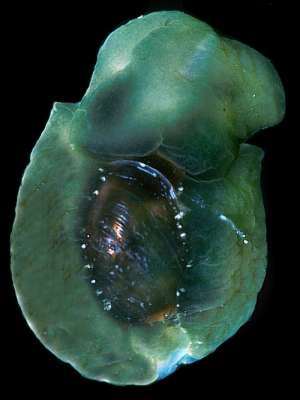
Smaragdinella calyculata
(Broderip & Sowerby, 1829)
Order: CEPHALASPIDEA
Superfamily: HAMINOEOIDEA
Family: Smaragdinellidae
DISTRIBUTION
Widespread Indo-West Pacific.
PHOTO
Upper & Lower Right: Druelu, Lifou, Loyalty Ids, New Caledonia, November, 2000. Many animals 14-20 mm long. AM C390347. Photos: Bill Rudman
Lower Left: Shells of animals from Manana Islet, Oahu Is, Hawaii, 1924. AM C61285 [largest shell 12mm long] Photo: Bill Rudman
Smaragdinella calyculata is green, sometimes with brown or white blotches along the edge of the parapodia. It is herbivorous. Smaragdinella is the closest thing to a 'limpet' amongst the cephalaspid 'bubble shells'. It lives at the same place on the shore as many limpets, and its compact shape and large muscular foot make it difficult to prise the animal off the rock at low tide. Its habit also resembles that of the sea hare Dolabrifera. Its anatomy however clearly shows that it is closely related to herbivorous bubble shells such as Haminoea and Phanerophthalmus. Its shell is very flattened, reduced to little more than the body whorl. Miller (1969) noted that in the Solomon Islands this species attached firmly to open, exposed rock surfaces, and produced large amounts of mucus, sometimes becoming very difficult to prise off. It was found uncovered at low water and was kept moist by the ocean spray. I haved observed similar behaviour in Lifou, Loyalty Ids.
The large headshield is relatively wide in front, narrowing slightly to form a rounded bilobed posterior end. The chemosensory Hancock's organs are brown and form a thin wrinkled ridge in the groove between the foot and the headshield on each side of the head. The penial opening is on the right anterior corner of the head and from it a ciliated seminal groove runs back to the genital opening at the anterior end of the mantle cavity opening. On each side the foot extends into a large lateral lobe, the parapodia, which fold over, partially enclosing the shell, which lies exposed on the the back of the animal. The shell is brownish green. It is relatively solid and flattened, reduced to little more than the body whorl. The upper whorls absent, except for a spoon-shaped projection from the columella. There can be some variation in shell shape, the extremes of shape illustrated in the photos in an accompanying message. However all variants can be found at the same locality so they are unlikely to represent specific differences.
The phylogenetic relationships of Smaragdinella are clearly seen when the alimentary canal is looked at. The broad radular ribbon, has many rows of hook-shaped teeth, reminiscent of HaminoeaAtys, and there is a gizzard with 3 chitinous plates bearing sculptured on the inner side with countless minute V-shaped grooves.
Many species of Smaragdinella have been described from their shells alone. Rudman (1972) showed that the shell of S. calyculata is very variable and it is possible to synonymise the species down to two or three species. One of these is the closely related species, S. sieboldi A. Adams, 1864, which is found in Japan, commonly on seaweeds and among oysters and barnacles between tide marks (Habe, 1964).
References:
• Habe, T. (1964) Shells of the Western Pacific in Colour. Vol.II. Hoikusha, Osaka. 233 pages.
• Miller, M. C. 1969. The habits and habitats of the opisthobranch molluscs of the British Solomon Islands, pp. 541-548. [In]: E. J. H.
Corner. A discussion of the results of the Royal Society Expedition to the British Solomon Islands Protectorate, 1965. Philosophical Transactions of the Royal Society London, series B, Biological Science, 255(800): 285-631.
• Rudman, W.B. (1972) The herbivorous opisthobranch genera Phanerophthalmus A. Adams and Smaragdinella A. Adams. Proceedings of the malacological Society of London, 40(3): 189-210, 11 figs.
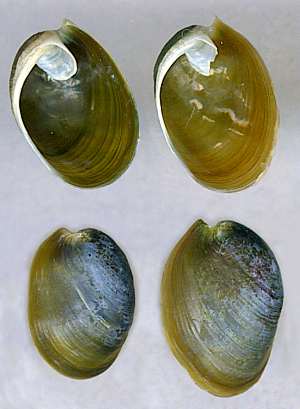
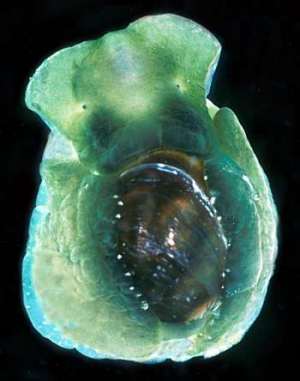
Rudman, W.B., 2004 (January 12) Smaragdinella calyculata (Broderip & Sowerby, 1829). [In] Sea Slug Forum. Australian Museum, Sydney. Available from http://www.seaslugforum.net/find/smarcaly
Related messages
Haminoeidae from South Vietnam
April 11, 2006
From: Alexei Chernyshev
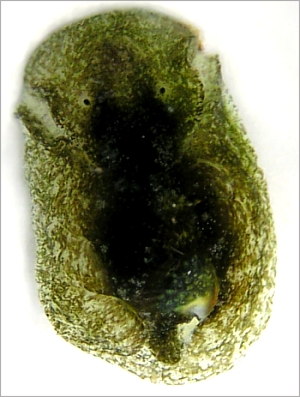
This unidentified species of Haminoeidae is common in intertidal zone of Van Phong and Nha Trang Bays. It inhabits dead shell of the barnacles Tetraclita squamosa.
Locality: Van Phong Bay, intertidal, Vietnam, Pacific Ocean, South Chine Sea, 15 January, 2005, from dead barnacles. Length: 11 mm. Photographer: Chernyshev A.V..
Alexei Chernyshev
tsher@bio.dvgu.ru
Chernyshev, A.V., 2006 (Apr 11) Haminoeidae from South Vietnam. [Message in] Sea Slug Forum. Australian Museum, Sydney. Available from http://www.seaslugforum.net/find/16265Dear Alexei,
This is Smaragdinella which I have described as the 'limpet' of the cephalaspideans - both in shape and position on the shore. It is most probably S. calyculata, but there is another species, S. sieboldii, described from Japan which has differences in shell shape which I describe in an earlier message [#11814]. However we know nothing about the living animal of S. sieboldii, so the only way to be sure of the identity of your animals at this stage would be to dissect out the shell of one of them and compare it with the shell of S. calyculata which is illustrated on the Forum [message #11863]. If it is different I would like a photo of the shell to add to the Forum.
Best wishes,
Bill Rudman
Re: Smaragdinella calyculata or S. sieboldii? from Japan.
January 26, 2004
From: Jun Imamoto
Dear Bill,
Thank you for your comments on my photo. This animal was found according to your expectations from under stones in shallow water. It is difficult to collect these animal's shells but I will see what I can do. It is good to know what the animal is.
Best Regards,
Jun Imamoto
http://www.umiushi.info/
imamoto@umiushi.info
Imamoto, J., 2004 (Jan 26) Re: Smaragdinella calyculata or S. sieboldii? from Japan.. [Message in] Sea Slug Forum. Australian Museum, Sydney. Available from http://www.seaslugforum.net/find/11891Smaragdinella calyculata or S. sieboldii? from Japan.
January 12, 2004
From: Jun Imamoto
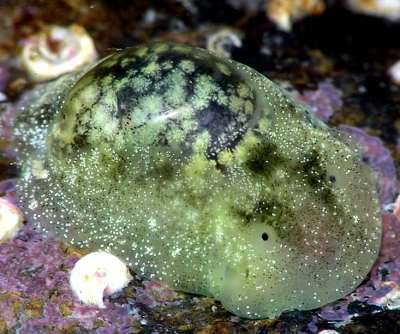
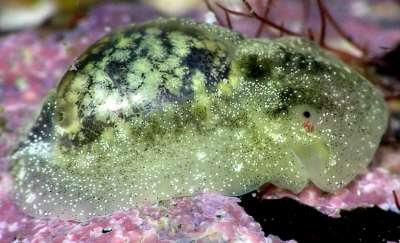
Dear Bill,
Here is a sea slug which I meet for the first time. I think it is a sea slug although it looks quite like a shellfish or kind of snail. However the the form of the head is like Bulla but it also seems to be Haminoea as well. I would be very happy for your comments.
31 December 2003
Amami Ooshima Islands, Kagoshima, Japan.
size: approx 8mm
depth: 1 m
temperature: 21 C
Best Regards,
Jun Imamoto
http://www.umiushi.info/
imamoto@umiushi.info
Imamoto, J., 2004 (Jan 12) Smaragdinella calyculata or S. sieboldii? from Japan.. [Message in] Sea Slug Forum. Australian Museum, Sydney. Available from http://www.seaslugforum.net/find/11814
Dear Jun,
This is a nice New Year's surprise! It is a species of Smaragdinella, a strange relative of Haminoea which we didn't have represented on the Forum. It is indeed a sea slug although its shape and flattened shell do make it look like a snail. One quite good way of telling a snail [shellfish] from a sea slug is that snails have their eyes on a stalk of some sort while in slugs the eyes are buried in the skin as you can clearly see in your animal.
You don't actually say where on the shore you found it, but in my experience it lives on rocky intertidal regions, often exposed at low tides. I think of it is as the cephalaspidean limpet, both because of its shape and place on the shore, where it sticks firmly to the rock and is hard to dislodge. The body is quite muscular and firm, except for the reduced parapodia which only partially cover the flattened ear-shaped shell.
My first thought is that this is a pale version of Smaragdinella calyculata, which I have just added to the Forum for comparison, but that species is usually more pigmented than yours. There is another species, S. sieboldi, which has been reported from Japan which differs in the shape of its shell, but unfortunately I know nothing about the shape of the living animal. It would be interesting to know what the shell of your animal looks like. From illustrations I have seen of the shell of S. sieboldi, it is colourless, not green, and instead of having a spoon-shape projection on the inner lip, it has a small body whorl as seen in species of Philine.
If anyone has a photo of the living S. sieboldii I would be interested in seeing it. Otherwise I would need to see a photo of the shell of this animal before I could be sure of an identification. Thanks for another interesting addition to the Forum
Best wishes
Bill Rudman
Shell of Smaragdinella calyculata
January 12, 2004
From: Bill Rudman

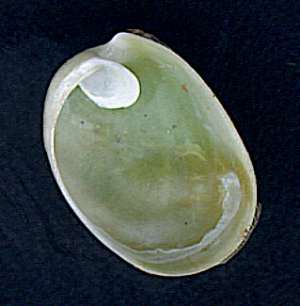
To accompany my posting of a Fact Sheet on Smaragdinella calyculata, here are some photos of the reduced shell of this species from the Australian Museum collections. As you will see the shell is very reduced consisting of little more than the flattened body whorl of the shell. The spoon-shaped projection on the inner lip is all the remains of the shell's inner whorls. Compare this with the shell of a related haminoeioid such as Haminoea zelandiae.
Upper Photo: Manana Islet, Oahu Is, Hawaii, 1924. AM C61285 [largest shell 12mm long]
Lower Photo: Honiara, Solomon Ids 1965. AM C159949 [shell 9mm long. see Rudman 1972]
As I discuss in the Fact Sheet the shell is quite variable in shape, as illustrated here [see Rudman, 1972].
• Rudman, W.B. (1972) The herbivorous opisthobranch genera Phanerophthalmus A. Adams and Smaragdinella A. Adams. Proceedings of the malacological Society of London, 40(3): 189-210, 11 figs.
Bill Rudman
Rudman, W.B., 2004 (Jan 12) Shell of Smaragdinella calyculata. [Message in] Sea Slug Forum. Australian Museum, Sydney. Available from http://www.seaslugforum.net/find/11863Smaragdinella calyculata from Lifou
January 12, 2004
From: Bill Rudman


To accompany Jun Imamoto's message concerning an animal which looks like Smaragdinella from Japan, here are a couple of photos of Smaragdinella calyculata from Lifou.
I found them at Druelu, on intertidal limestone rocks in the surge zone with Siphonaria and other limpets. They were quite abundant and ranged in length from 14-20 mm. Their colour was in various shades of green with bright white patches around the parapodial edge. In some animals there were a few white specks scattered on the parapodia as well. [Lifou, Loyalty Ids, New Caledonia, November, 2000. AM C390347. Photos: Bill Rudman]
As I discuss in the Fact Sheet, Smaragdinella is the closest thing to a 'limpet' amongst the cephalaspid 'bubble shells'. It lives at the same place on the shore as many limpets, and its compact shape and large muscular foot make it difficult to prise the animal off the rock at low tide. Its habit also resembles that of the sea hare Dolabrifera. Its anatomy clearly shows that it is closely related to other herbivorous bubble shells such as Haminoea and Phanerophthalmus. As I illustrate in a separate message, its shell is very flattened, reduced to little more than the body whorl.
Best wishes
Bill Rudman
